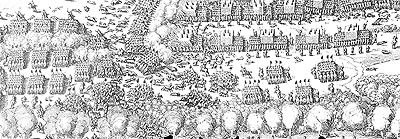 Theodore Dodge wrote in his tome, Gustavus Adolphus, that the
Thirty Years War did not have grand tactics. He was not alone in that
belief. Dodge served in the American Civil War and studied Napoleon's
campaigns, as well as those of the 17th Century. In order to grasp this
statement, we must define Grand Tactics. The Tactical level is a lower
level looking at the conduct of companies, battalions and squadrons in
winning their local engagements, also known as actions that, in sum,
comprise a battle. The Operational level is the maneuver and logistics
associated with winning a campaign.
Theodore Dodge wrote in his tome, Gustavus Adolphus, that the
Thirty Years War did not have grand tactics. He was not alone in that
belief. Dodge served in the American Civil War and studied Napoleon's
campaigns, as well as those of the 17th Century. In order to grasp this
statement, we must define Grand Tactics. The Tactical level is a lower
level looking at the conduct of companies, battalions and squadrons in
winning their local engagements, also known as actions that, in sum,
comprise a battle. The Operational level is the maneuver and logistics
associated with winning a campaign.
As armies grew and wings and corps become a standard component, there came an area of study between the Tactical and Operational level, the Grand Tactical level. Grand Tactics is the arrangement and maneuver of the Corps or Wings of an army to win a battle.
What Dodge was getting at is that the conduct of battles was a line-them-up-go-at-it approach, with little finesse. This is very much the character of battles in the Medieval and Renaissance periods. In many studies most of the attention is paid to the tactical differences between the Swedish, French, Imperial and Spanish troops as means of explaining the outcomes of the battles.
Some newer research presented by Geoffrey Parker and Richard Brzezinski indicates that this previous emphasis on tactical differences is overstated. In addition, many battles after the death of Gustav Adolphus have been neglected, despite the compelling evidence of sophisticated techniques employed.
THE AXIOMS OF WAR
These are mine based on the study of the era to consider as a 17th Century general are as follows:
- To defend is stronger. (Thanks to the improved killing power of firearms.)
- To win you must attack. (Fire without maneuver is indecisive.)
- You must maintain a reserve; if the reserve is committed, reconstitute one as quickly as possible. Generally the last to commit his reserve wins.
- Cavalry is the arm of decision. (Cavalry though taken down a notch by the power of musketry supported by pikes could still out maneuver foot and artillery and held the higher elan based on the manpower pool it drew from.)
- Keep it simple. (Given the fact that staff were very small if they existed at all, and communication, being person to person, made complex plans very problematic.)
- Flanks attacks / enfilading fire is much more effective than frontal attacks / fire.
- If the enemy doesn't give you a flank - make one. Attack to separate his wings to create flanks.
The basic organization of an army in the field was based on the medieval model. It was comprised of three wings or corps. The Vanguard was the first in the order of march and was responsible for reconnaissance and security, thus was often exclusively cavalry. When forming the army for battle the vanguard formed on the right, the position of honor. The Center was the infantry and comprised the bulk of the manpower, half to twothirds of the total strength. Deployment of the foot was the slowest and the Vanguard had to cover this.
The Center's main task was assaulting a position or defending a position. Last in the order of march and forming on the left of the army was the Rearguard. Also tasked with security, like the Vanguard was mostly cavalry. In the Thirty Years War, armies were a third to half cavalry. The horse was divided more or less evenly between the Vanguard and Rearguard; often there were a small number of cavalry units to support the infantry in the Center or Corps de Bataille.
The tactical formations -- the units that made up the wings -- were infantry battalions and cavalry squadrons. Wings could operate independently of the others, and often battles involved distinct sets of actions fought by the various wings that were seemingly unrelated to each other. It was the accepted practice that each wing withheld a reserve, most often by forming in two, or on narrow frontages three, lines. This generally accepted practice helped put everyone on the "same sheet of music" or a common point of reference.
Back to Table of Contents -- Against the Odds vol. 2 no. 1
Back to Against the Odds List of Issues
Back to MagWeb Magazine List
© Copyright 2003 by LPS.
This article appears in MagWeb.com (Magazine Web) on the Internet World Wide Web.
Other articles from military history and related magazines are available at http://www.magweb.com
* Buy this back issue or subscribe to Against the Odds direct from LPS.
